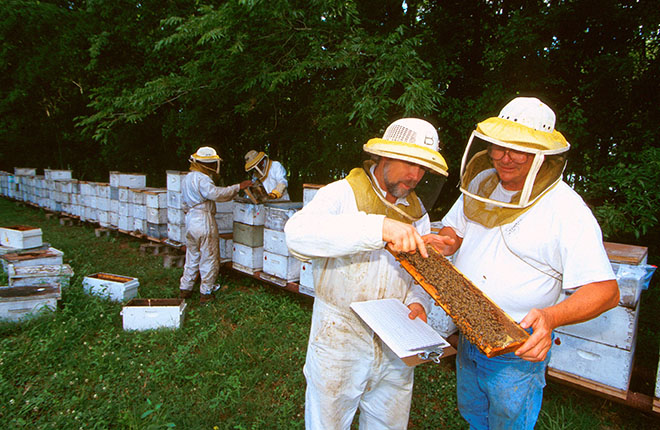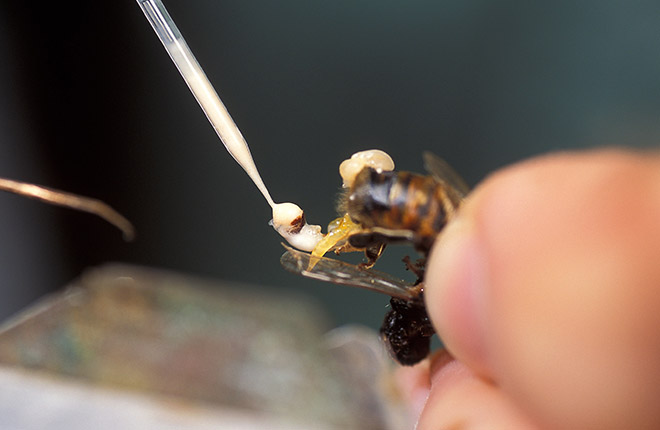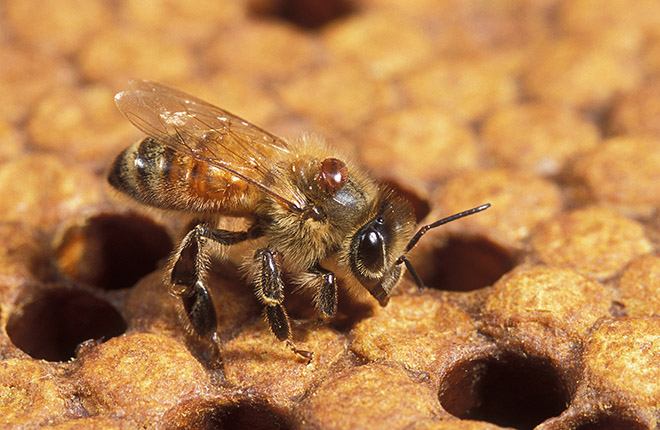New Bee Germplasm Collection
The first in our series on the vital contributions of the ARS collections that conserve our genetic wealth. See Germplasm Collection Series under Additional Information.
Like the great storehouses of the past, full of amassed treasures, the Agricultural Research Service’s germplasm collections today preserve a wealth of genetic material, which is a critical national and international resource. These collections fall into three general categories: small, individual research collections; reference collections; and large, national, genetic-resource collections. Their value to scientists, breeders, agriculture, and indeed all of us, is almost beyond measure.
This year brings a new ARS germplasm collection: The National Bee Genebank in Fort Collins, Colorado. It is part of ARS’s response to the ongoing crisis that the country’s beekeepers are facing. In the past three decades or so, new pathogens, pests, parasites, and pressures, such as sublethal impacts of pesticides and deficient nutrition, have increased average losses of managed honey bee colonies to more than 30 percent a year. These stresses have helped push commercial beekeepers to a precarious economic position, threatening their continued business sustainability.
The addition of an ARS bee collection will ensure that genetically diverse honey bee germplasm will be preserved for traits such as resistance to particular pests or diseases and for pollination efficiency. The genebank can help ARS and other researchers around the country to breed better bees now and in the future.
“For example, once the genebank is organized, it will ensure that the Russian honey bee and the Varroa Sensitive Hygiene lines we developed here are kept safe. It will also provide greater access to them for other researchers without requiring our lab to spend so many resources to maintain colonies of these lines,” says entomologist Robert Danka, with the ARS Honey Bee Breeding, Genetics, and Physiology Research Unit in Baton Rouge, Louisiana. Danka is helping to shape the bee genebank.
To help make the genebank a reality, researchers in the ARS Insect Genetics and Biochemistry Research Unit in Fargo, North Dakota, are developing better long-term storage techniques for honey bees, including cryopreservation of bee sperm and embryos. Their work will include creating a way to reliably revive the embryos and grow them into reproductively viable adults after storage. The lab has had success developing such protocols for other insect species. When this research is complete, it will allow honey bee germplasm to be preserved for the long term outside of living colonies.
The other component of creating a new collection requires forming a “germplasm species committee” to decide what species and subspecies need to be collected and preserved and who will have access to particular parts of the collection.
“We are working with the bee program at Washington State University to talk to beekeepers—especially to prominent queen breeders, and to researchers from universities and private industry—about how this committee should be organized and what needs to be in the collection,” said Danka. “Many honey bee lines have been developed by private companies, and while we want them and their genes preserved for the future, access has legal aspects that have to be respected.”
Deciding what will be collected in the National Bee Genebank, beyond the initial lines ARS has, could be a very large job. First, there are the honey bees, which are not native to the New World; they were brought here by Europeans starting in the 1600s. Today, most U.S. beekeepers are only managing one subspecies of honey bee: the Italian Apis mellifera ligustica,thought to have originated south of the Alps and north of Sicily.
But there are perhaps two dozen other subspecies in the wild that are not used as widely here commercially. In Europe, for example, they also extensively use the Carniolan honey bee (Apis mellifera carnica), originally from Slovenia. Importing and storing germplasm from these types of foreign populations can provide long-term opportunities for researchers and industry to develop new bee varieties as they deem appropriate.
“Once the collecting and storage of honey bee germplasm is under way, there will be a need to determine how to approach collecting and storing other pollinators, such as the non-Apis bees,” says geneticist Harvey D. Blackburn, who oversees the ARS National Animal Germplasm Program in Fort Collins, which also curates livestock, aquatic species, and other insect germplasm. The new bee collection will be housed there too, beginning with existing cryopreserved germplasm samples from ARS laboratories or from universities.—By J. Kim Kaplan, Agricultural Research Service Information Staff.
“New Bee Germplasm Collection” was published in the January 2016 issue of AgResearch Magazine.
Key Facts
- ARS bee collection ensures genetically diverse honey bee germplasm will be preserved.
- Genebank helps ARS and other researchers around the country breed better bees now and in the future.
- Germplasm species committee will decide which species and subspecies to collect and preserve.
Full Story










